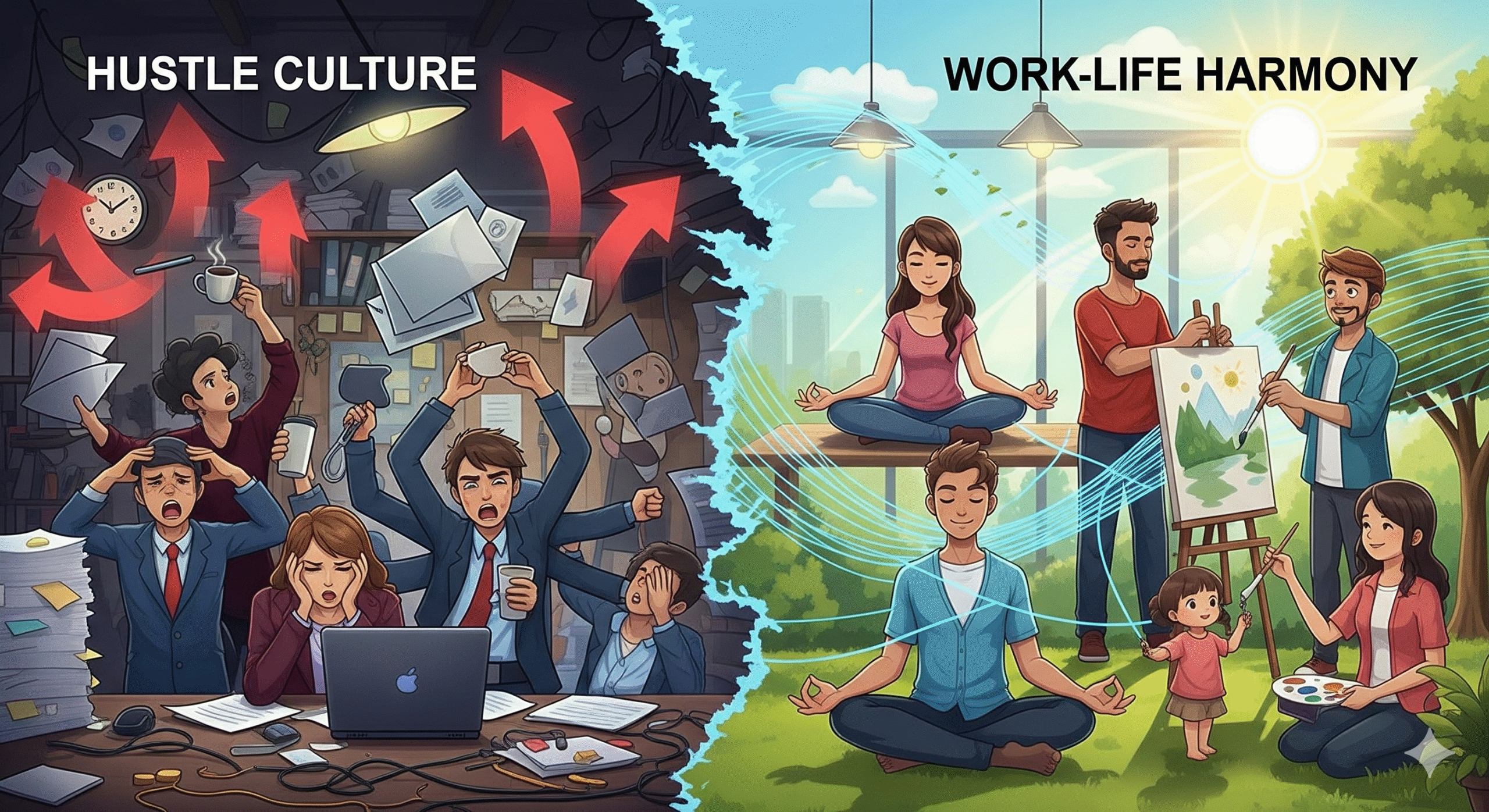The New Definition of Success is Not What You Think
Have you ever felt like you’re running on a treadmill that’s speeding up every year? You work longer hours, chase the next promotion, and collect the latest “status symbols,” only to feel a nagging sense of emptiness. For a long time, society told us that success was a straight line: work hard, climb the ladder, earn more, and you’ve “made it.” This relentless pursuit, often glorified as “hustle culture,” has left a generation burnt out, anxious, and questioning the very meaning of achievement.
But something is shifting. In 2025, a new paradigm is emerging. We’re moving from a culture of perpetual hustle to one of intentional harmony. Redefining success today isn’t about working harder; it’s about working smarter and living more fully. It’s about building a life where your career, relationships, health, and personal growth all exist in a symphony, not a frantic, discordant race. This article will explore this monumental shift and provide a blueprint for anyone ready to embrace a more balanced and fulfilling life.
The Rise and Fall of Hustle Culture
For decades, hustle culture was the dominant narrative. It was the mantra of Silicon Valley startups, Wall Street traders, and ambitious entrepreneurs. The core belief was simple: success is a function of effort. The more you “grind,” the more you “win.” This mentality was amplified by social media, where highlight reels of early mornings, late nights, and packed schedules became a form of digital virtue signaling. The “sleep when you’re dead” philosophy became an anthem for a generation, pushing them to the brink of exhaustion.
But the cracks in this foundation have become undeniable. The glorification of overwork has led to a global burnout epidemic. A 2024 Gallup study found that 41% of employees reported feeling burned out, a number that has been steadily climbing. Chronic stress, anxiety, and a sense of alienation from family and friends are the hidden costs of a life spent in relentless pursuit of professional milestones. The COVID-19 pandemic acted as a catalyst, forcing many to hit the pause button and re-evaluate their priorities. With the rise of remote and hybrid work, the lines between professional and personal life blurred, making the need for a new model of success more urgent than ever.
The old definition of success—high earnings, a stable job, and a high-ranking position—still holds value, but it’s no longer the whole picture. Today, people are increasingly prioritizing personal fulfillment, mental well-being, and having a sense of purpose. This is the foundation of the shift from hustle to harmony.
A Detailed Comparison: Hustle Culture vs. Work-Life Harmony
To understand this transformation, it’s helpful to see the two ideologies side by side.
| Feature | Hustle Culture | Work-Life Harmony |
| Core Belief | Success is the result of continuous, relentless effort. | Success is a state of fulfillment achieved through balance and integration. |
| Primary Metric | Output, income, promotions, and status symbols. | Well-being, personal growth, meaningful relationships, and a sense of purpose. |
| Time Management | Maximizing every minute for work, often at the expense of sleep and leisure. | Intentional time-blocking for both work and personal activities. |
| Approach to Work | A constant “grind” with a focus on doing more and always being “on.” | A focus on efficiency and deep work, with periods of rest and recovery. |
| Relationship to Self | Self-care is a reward earned after hard work. | Self-care is a non-negotiable part of the routine, essential for sustained performance. |
| View of Rest | Rest is a sign of weakness or laziness. | Rest is a productive and necessary component of high performance. |
| Motivation | Fueled by external validation, competition, and a fear of falling behind. | Driven by intrinsic fulfillment, personal values, and a desire to contribute. |
| Outcome | High risk of burnout, stress, and professional stagnation. | Increased resilience, creativity, and long-term, sustainable success. |
Export to Sheets
This table illustrates that the shift isn’t just about a change in schedule; it’s a fundamental change in mindset. Work-life harmony doesn’t mean you’re not ambitious or dedicated. It means your ambition is sustainable, fueled by purpose, and supported by a healthy, integrated life.
Key Features and Benefits of Redefining Success
Embracing the harmony model offers a multitude of benefits, both for individuals and the organizations they work for.
1. Improved Mental and Physical Health
The most immediate benefit is a dramatic reduction in stress, anxiety, and burnout. By prioritizing rest, exercise, and a healthy diet, individuals can build resilience and improve their overall well-being. This leads to fewer sick days and a workforce that is more present, focused, and mentally sharp.
2. Enhanced Productivity and Creativity
Contrary to the belief that long hours equal higher productivity, studies have consistently shown the opposite. A well-rested mind is a creative mind. By allowing for downtime and a break from the constant pressure, individuals can come up with innovative solutions and deliver higher-quality work. The four-day workweek, which some companies have successfully adopted, is a testament to this principle, demonstrating that fewer, more focused hours can lead to the same or even better results.
3. Deeper, More Meaningful Relationships
Hustle culture often puts a strain on personal relationships. By dedicating time to family, friends, and community, individuals can nurture the connections that provide emotional support and a sense of belonging. This social capital is a crucial component of a fulfilling life and acts as a buffer against professional challenges.
4. Long-Term Career Sustainability
The harmony approach is about playing the long game. Instead of sprinting toward a finish line and burning out, it’s about building a career that can be sustained over a lifetime. It fosters a growth mindset, where success is not just about a single achievement but about continuous learning, personal development, and adapting to a changing world. This makes individuals more valuable to their organizations and more resilient in their own careers.
5. Increased Job Satisfaction and Employee Retention
When employees feel valued, respected, and have the freedom to live a full life outside of work, they are more likely to be satisfied with their jobs. This translates to lower employee turnover and a stronger, more committed team. Companies that embrace work-life harmony are attracting top talent who are looking for more than just a paycheck.
Pros and Cons of This Shift
Like any major change, redefining success has its own set of challenges and advantages.
Pros
- Greater Fulfillment: A shift from purely material goals to personal and professional fulfillment.
- Reduced Burnout: Creates a sustainable pace for long-term career success.
- Increased Innovation: Rest and downtime foster creativity and problem-solving.
- Stronger Communities: More time for personal connections and community engagement.
- Healthier Workforce: Leads to better mental and physical well-being for all.
Cons
- Perceived Laziness: Some may view a harmony-focused approach as a lack of ambition, especially in traditional industries.
- Difficulty in Setting Boundaries: For many, the ingrained habit of being “on” is hard to break. It requires conscious effort to set and maintain boundaries.
- Navigating Management: Managers who were raised in hustle culture may struggle to trust employees who aren’t constantly visible or online.
- Social Pressure: The lingering social media glorification of hustle culture can create feelings of inadequacy or “missing out.”
- Uncertainty: For those who have always defined themselves by their work, this shift can feel disorienting and require a complete re-evaluation of their identity.
Use Cases: Who Should Embrace This Model?
The “from hustle to harmony” model is not a one-size-fits-all solution, but it is applicable across a wide range of individuals and organizations.
The Overworked Professional
If you’re an ambitious professional who feels trapped in the 9-to-5-and-beyond cycle, this model is for you. It provides a framework for taking back control of your time and energy, allowing you to excel at work without sacrificing your personal life. It’s for the lawyer, the tech engineer, the doctor—anyone in a high-demand field who is on the brink of burnout.
The Modern Entrepreneur
For years, the startup founder’s story was one of all-nighters and constant grinding. But a new generation of entrepreneurs is realizing that a sustainable business requires a sustainable leader. This model is for founders who want to build a profitable company without losing their health or their relationships. It’s about building smarter, not just faster.
Companies Seeking to Attract and Retain Talent
In today’s competitive job market, compensation is no longer the sole determinant of a company’s appeal. The most sought-after employees are looking for a culture that values their well-being. The harmony model is a blueprint for HR leaders and executives who want to create a supportive, flexible, and ultimately more productive work environment. Companies like Atlassian and Salesforce, known for their flexible work policies and focus on employee well-being, are prime examples of this in action.
Anyone Feeling Unfulfilled
Perhaps you’ve “achieved” all the traditional markers of success but still feel a deep sense of dissatisfaction. This model is for you. It offers a path to re-evaluate your values and build a life that is truly aligned with what brings you joy and purpose, not just what brings you money or status.
FAQs: Redefining Success in the Modern Workplace
Q1: How can I start redefining success for myself?
A: Start by defining your “non-negotiables.” What aspects of your life—family time, hobbies, exercise, rest—are you unwilling to sacrifice? Once you have this list, build your schedule around it. Then, set clear boundaries with your work and communicate them to your team and manager. Remember, this is a journey, not a destination.
Q2: Is “work-life harmony” the same as “work-life balance”?
A: Not exactly. “Balance” suggests a strict 50/50 split, a tug-of-war between two opposing forces. “Harmony” implies integration. It’s about how your work and personal life can complement each other. For example, a hobby might spark creativity for a work project, or a flexible work schedule might allow you to attend your child’s recital without stress. It’s a fluid, dynamic relationship rather than a rigid scale.
Q3: What if my company doesn’t support this approach?
A: You’re not alone. The shift often starts with individuals. Begin by demonstrating the benefits of this approach through your own performance. Show that you can be more productive, focused, and innovative when you take care of yourself. Additionally, look for companies that align with your values. The market is increasingly rewarding organizations that prioritize well-being.
Q4: How do I manage the guilt of not “hustling”?
A: This is a common and challenging aspect of the transition. The guilt is often a byproduct of deeply ingrained societal norms. The key is to reframe your perspective. View rest not as a luxury or a sign of weakness but as a strategic tool for high performance. Recognize that your worth is not tied to your productivity or the number of hours you work. It’s a mindset shift that requires practice and self-compassion.
Q5: Will I still be able to achieve great things if I’m not hustling?
A: Absolutely. Great achievements are not born from exhaustion; they are born from sustained focus, creativity, and resilience. The harmony model is designed for long-term, sustainable success. It’s about building a life that allows you to show up as your best self, consistently, over a long period. Many of the world’s most successful leaders and innovators are now championing this approach.
Q6: How does technology fit into this new model of success?
A: Technology is a double-edged sword. It can be a source of constant distraction and pressure (e.g., being “always on”), but it can also be a tool for creating harmony. Use productivity apps to streamline your work, automate routine tasks, and set digital boundaries. Leverage flexible work technologies to design a schedule that works for you. The goal is to use technology to serve your life, not to be a slave to it.
Conclusion: The Path to a Fulfilling Future
The era of relentless hustle is drawing to a close. In its place, a more thoughtful, human-centered approach to success is taking hold. Redefining success in 2025 is an act of empowerment. It’s a choice to stop chasing someone else’s definition of achievement and to start building a life that is truly your own.
This isn’t a radical idea; it’s a necessary evolution. As the world becomes more complex and the demands on our time and energy increase, our old models of success are no longer serving us. By moving from hustle to harmony, we are not just creating better careers; we are creating better lives. We are building a future where professional excellence and personal fulfillment are not at odds, but in perfect, beautiful sync.
Final Verdict: The Harmony Model is the New Standard
The evidence is clear. From a productivity standpoint to a personal well-being perspective, the harmony model is not just a trend; it is the new standard for sustainable success. For individuals, it offers a path to a more fulfilling, less stressful life. For companies, it’s the key to attracting and retaining the best talent. The most successful people and organizations in the coming years will be the ones that have mastered this delicate but powerful dance between work and life. The future of success is not about the grind; it’s about the flow. It’s about finding your rhythm and creating a life that is a masterpiece of your own design.







Leave a Reply